Donatien Grau: I have a sense that, in your recent work, the question of humanity has become more and more explicit. There has been a series of titles—Humains par hasard [Humans by chance, 2016], Joyeux animaux de la misère [Joyous Animals of Misery, 2014], Par la main dans les Enfers [By the Hand into the Hades, 2016]—that echo one another and call our humanity into question. Where do you stand these days on this question?
Pierre Guyotat: I’ve always dealt with that question. It’s nothing new, and it necessarily lies at the core of every work of art. To begin with, we have to decide what we mean by humanity. Do we mean humanity in the sense of humane sentiment? Do we mean the current mass of humanity, or evolution, or humanity with respect to a divinity? Or, especially, humanity versus inhumanity?
For years during my youth, when I was about thirty, I did indeed wittingly focus on humanity’s material aspect, its organic aspect—my psychoanalytic period. I was wary of all metaphysics, all psychology. For me at that time humanity was reduced so specifically to its bodily expression that things always came to a sort of burst. Every body bursting, every body exploding, as at the end of Eden, Eden, Eden, in 1970… Now is when I’m realizing this. When I do a reading of that book, especially of the end, I realize that it wasn’t just bodies exploding into scattering body parts out of sexual need. It was also that particular notion of exclusive corporeity, of corporality, coming into play.
For a long, long time I was “the body writer,” and I still am, alas. There’s still some body left. There’s still a bit of body, so there’s already an explosion from that. Philippe Sollers’s preface to Eden, Eden, Eden hints at the explosive side. Later it was language that exploded. It was absolute writing [l’écriture absolue], the horizontal act, what in the early 1970s I called the basic text, that exploded into voices. It was voices—in Prostitution, in 1975—that very quickly came to convey the explosion, that came to speak in lieu of the exploded body, of the exploded material body, or materialist body. It was, I think, the impossibility of going any further… In the end it’s the voice that conveys the description, the story, the statement, even if the voice is dispersed, or itself explodes. When I was working with the basic text, in 1970–1971, I would look for a first sentence that would lend the body the most intense possible corporality. And early on I got stuck: which of the body’s atoms should I start the text with? It couldn’t be a mere babbling. That was out of the question. This goes to show that for me the practice of art, or the need to make art, runs very deep, amounts to a philosophical need. It’s not merely aesthetic.
The use of voices is perhaps an admission of weakness… The vocal was already present in the text, in the form of a voice and a parallel voice. Leiris magisterially points this out in his preface. It was this voice that took charge when it proved impossible to get right down to the real: to get microscopically close, in fact… I wanted to find a literary, artistic equivalent in phrasing to atomic reality. And in the end I have perhaps been able to render that reality through the voice, through speech. I often look at vocalization as an easy, fun solution. It’s using voices that led me back to the notion of humanity, collectivity, echoes, conviction, seduction, pleas for help. By using voices I have rediscovered what we call humanity.
D.G.: Your humanity—or, at any rate, the humanity in your work—is always out of phase with itself. From Prostitution onward the language ceases, happily, to be standard contemporary French, and the creatures cease to be fully human. What, then, is your interest in humanity, being that its manifestation in your work is off-kilter from humanity?
P.G.: We should perhaps conclude that humanity no longer holds much interest for me for the purposes of fiction. I’ve given it brief appearances since then in the figures of brothel-goers in my fiction.
Also, perhaps humanity is appalling in the flesh for someone who lives it as intensely as I do, or else perhaps the real thing is too complex. I’m not the first to create a world of human appearance that tries to be human through and through, and is subject to the usual, ordinary human laws, the most summary laws, and then to create figures that are subject to a different law, a law that is indeed no longer human. Very gradually, starting with Progénitures [2000], I have deprived these human figures of rudimentary human rights and even of the right to consider themselves human. This is perhaps a result of the trauma I suffered with the coma I fell into in 1981 and emerged from in 1982—a “resurrection” during which I was unable to say “I” and thus, for a time, unable to write.
I’ve also gradually come to think that I cannot allow human figures to languish in such slavery, even if it’s joyful and relatively consensual slavery. I couldn’t maintain that world, that body, within human law, in the human state. So I took things much further. In Progénitures I made those whore figures into non-beings—in the sense of non-existing, rather than of non-existence. This has nothing to do with the philosophy of my generation. I’ve found nothing to top non-beings. I’m of a generation that comes out of the most dreadful negation of man in the known, archived history of man. This is not in any way a regression into the past, as they say. It is perhaps, alas, a prefiguration.
D.G.: A prefiguration of what?
P.G.: Of I know not what. I see this work, my work, as a kind of insurance against a possible future. I’m also trying, very paradoxically, to soften what has happened. I think using non-beings, and making them into rather glorious figures, lovely figures, is also a way to reconsider what has happened. To soften what’s to come, by hand. A way to lay a hand on the shoulder of future victims. That’s how I see it.
In the naiveté of my childhood I would have liked to take by the hand all the women and men who were on the verge of death. Everything I do amounts to that: holding hands with someone else. Once the monster is born nothing can stop it. It took years, and gigantic armies, to slay the monster. There are tyrannies, there are wars, and then there are monsters that appear, that are impossible to bring to heel. Satan must pass.
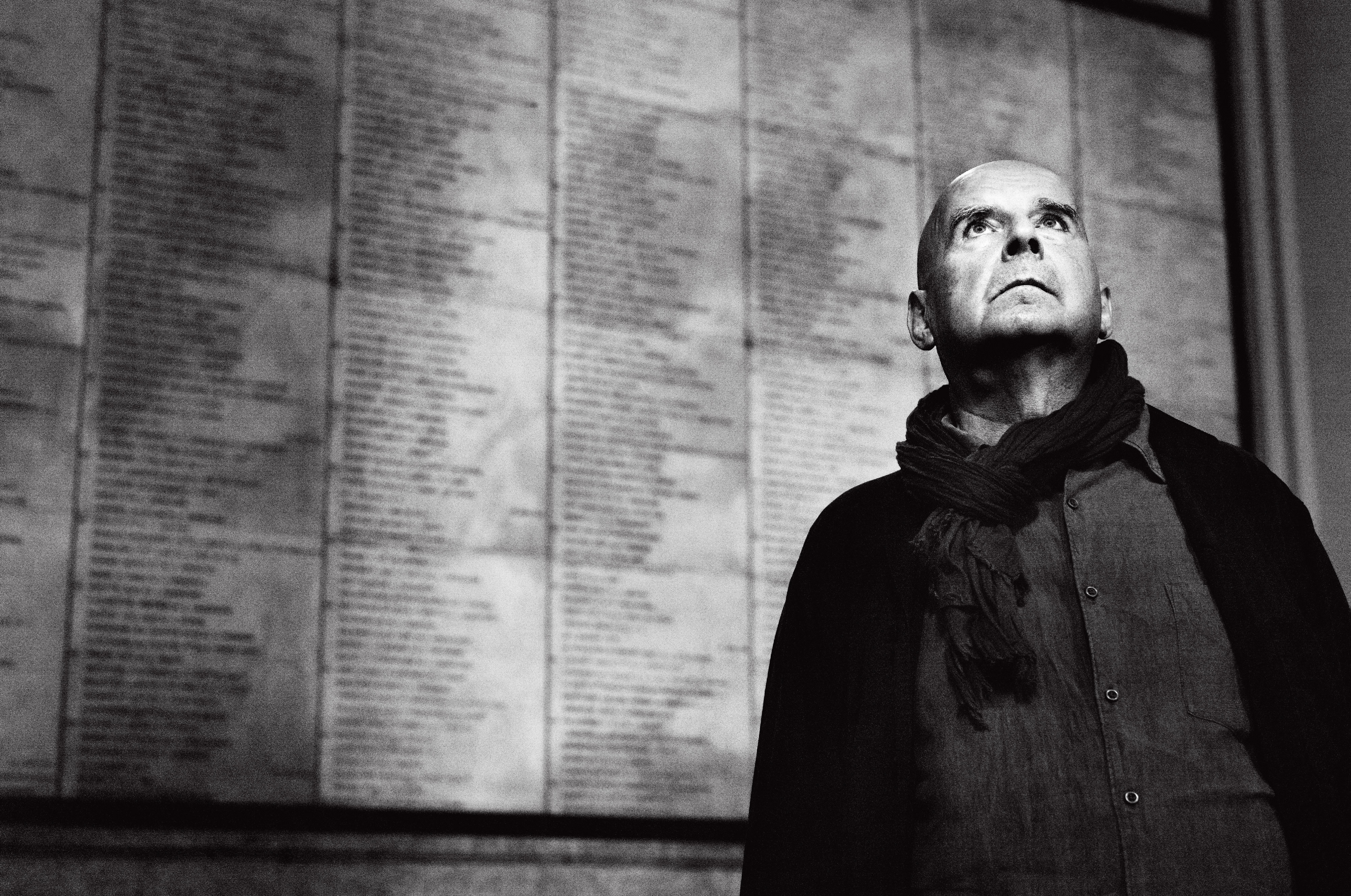
In front of commemorative plaques in the chapel of the Cimetière de Picpus displaying the names, professions, and dates of birth and death of 1,306 victims of the terreur. Those guillotined on the Place du Trône renversé between June 14 and July 27, 1794, until the overthrow of Robespierre, were buried here in a mass grave.
Photo: Mathias Bothor
D.G.: How have your figures evolved over the years?
P.G.: There’s now more and more jealousy between the figures, more play, more comedy. Everything is comic. It’s a behavioral psychology between animal and man, a sort of parody of psychology. What I do is very much parody, and I’m dead set on that.
In art you conduct revolution through parody. You parody the greatest achievements. You enlarge them, thicken them, draw a circle around them; you draw a circle around forms that have remained classical, and thereby lay them bare. You must point a thing out before you can get beyond it. Also, you must show yourself what needs to be gotten beyond: the style of tragedy, or comedy. That is what I call parody.
I parody to achieve something new. A revolutionary is someone who knows tradition cold. You have to see it, grasp it, show it, frame it. You practically have to hem it in and take charge of it: l’encadrer in every sense of the term.
What I do is a parody of rhetoric: the rhetoric of oratory, the rhetoric of Racine, the rhetoric of Hugo, Rimbaud, everyone. There’s no end to it. The further I advance, the more figures I annex. You have to have a very strong sense of melody to make it palatable.
D.G.: You were speaking of revolution in art. Do you still believe in it?
P.G.: Yes, or I wouldn’t be sitting here with you now. I cannot do otherwise, because I’m on the inside.
D.G.: Where, then, is the revolution in what you do?
P.G.: In a number of things. It’s in details. It’s in the whole, in the overall. It’s in my idea of parody. It’s in the figures. They don’t seem like much, but non-beings are not the usual thing. What I do isn’t science fiction either; it’s not tales of fantasy. There are overtones of tales, but of fairy tales, children’s stories. Scary stories, the kind that have always been around, and are part of the parody. There’s revolution also in my daring to set up a world like that in a language to match.
D.G.: So what is the purpose of your revolution?
P.G.: Let’s say that that idea has less of a hold on me now than when I was in my thirties. Now that I’ve found my way in, the thing can practically take off and soar without me. I no longer have the political engagement to go along with it. And is there such an engagement to begin with?
In detail it’s a conjunction of those positions. Instead of “on the table” I write “the table”. It doesn’t seem like much, but it’s a huge deal, and it’s all bound up in a particular rhetorical system. A particular scene. It’s neither imaginary, really, nor realistic. It’s melody. That is what I need. That is what fills my throat. Melody.
D.G.: You’ve said about your work: “It operates practically without me.” Can you picture someone carrying on your world after you, someone carrying on your language?
P.G.: Some revolutionaries have been followed and others not at all. In music, in painting, it’s as clear as day. Stravinsky has had no posterity. He didn’t write a theoretical work like Schoenberg, who laid it all out, and codified it…and thus has a posterity.
It’s a question I often asked myself in 1980, and which has had some rough consequences, because there’s no revolution without inner turmoil. It’s surprising, too, that at the time the people closest to me, even if they didn’t understand it, never even dared put into words the reason for the crisis I was going through, obvious as that reason was. It just ate away at me, which lends me a certain legitimacy when I say what I say. I truly suffered giving birth to this. I thought what I was doing amounted to a sort of personal dialect that could never be understood or shared. But that is obviously not the case. Committing that kind of act all alone is an excruciating experience.
I wondered how I could justify what I was doing. Now it’s a non-issue for me. But that is what revolution is: you are in no way sure of what you’re doing, absolutely not. I was never sure of what I was doing. When I was languishing in my prison cell in Algeria, in the spring of 1962, I was not at all sure I was right. I think I recall the first line of Carnets de bord, from March 1962, is: “Nothing, nothing is pure.” What does that mean? That I am no more right than my interrogators and tormentors. And what do you do when you’re uncertain and frightened? You sing like a child in the forest. You sing to buck yourself up.
D.G.: In the first books you published, Ashby and Sur un cheval, you were establishing a relation to the world founded on the clinamen. In the beginning you spoke of the atom, and in atomism everything is indeed divided into atoms, but there is also the clinamen, which is the way atoms are all bound to one another. We find that same tension in your work: separation and multiple associations, leading up to a fluid notion of relations, a fluidification of humanity. Do you agree?
P.G.: I’m not sure about the fluidification. If possible, you must take every step forward with the entirety of humanity. This might be a Christian notion. Humanity must unite: the good, the bad, the monstrous. Speaking of humanity, I’ve remembered what was haunting me at the time of Eden, Eden, Eden: it was that humanity was in an evolutionary state. That is once again becoming very important in my work. I think my future writing will very much take that into account.
We are an evolving species in a space that is itself evolving. Five hundred million years ago the Earth was not yet what it is now. A billion years ago it was still a fusing mass, and uninhabitable. We’re atop something that has been inhabitable only for the past few hundred thousand years. Once you come to that understanding you start to look at things differently. You might start walking differently. It’s as dizzying as when a child starts to realize that he’s walking on something that revolves, that is round, that hasn’t been round for long, that has only recently taken shape as a ball. For the child it’s extraordinary. How does a child take that in? How does a child take in the idea that he’s walking “head down”? We must get back to basics. We are but a stage, and we live on a ground, an object, that is but a phase.
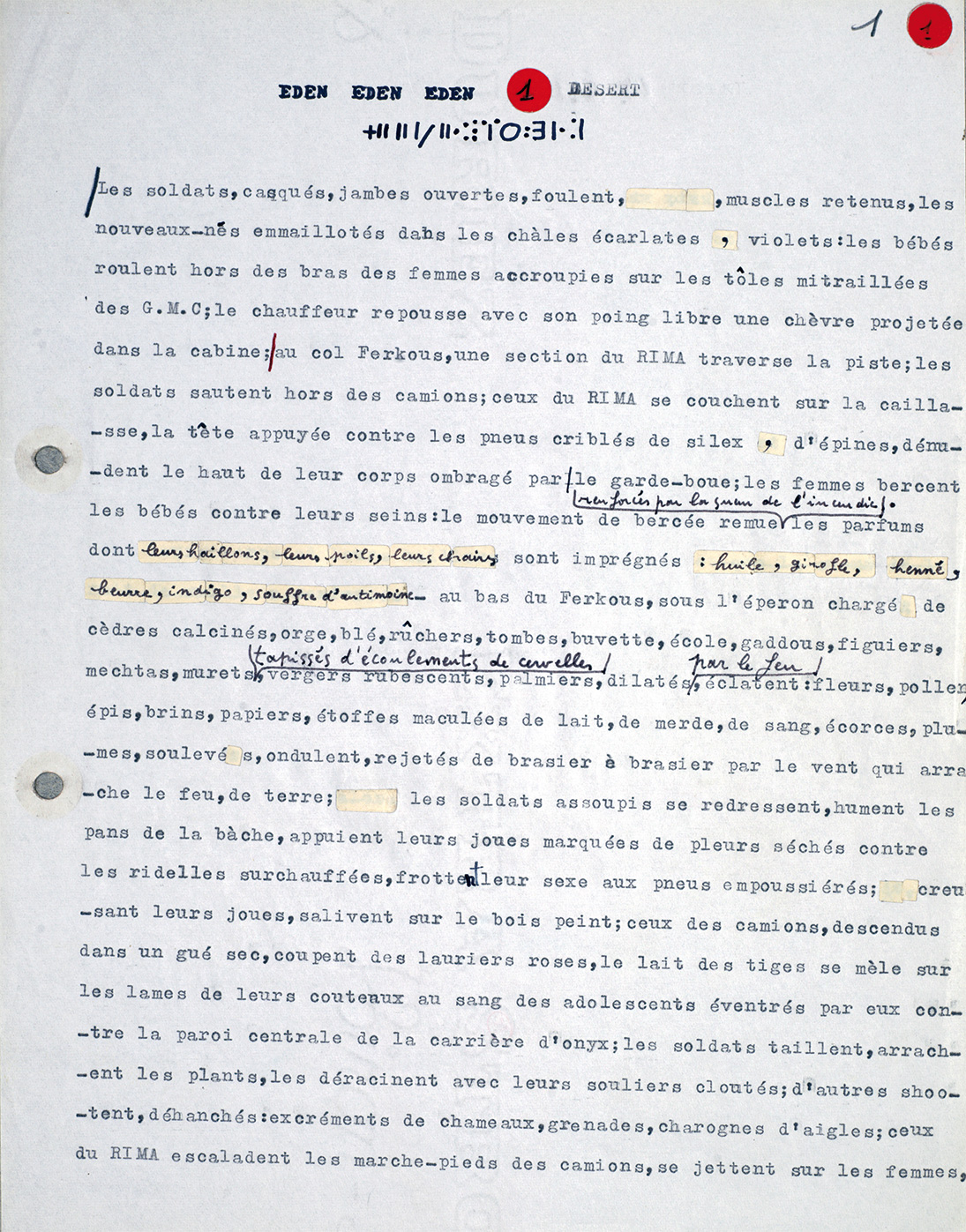
Typescript, the first page of text from Eden, Eden, Eden (1970):
“The book opens with a sentence in Tifinagh, the script of the Tuareg, which is not much in use and barely known. I translated the sentence ‘And now we are no longer slaves’ a little roughly, but that doesn’t matter. The text relocates French literature. It is a fiction entirely out of the Sahara.” P.G.
D.G.: But does your work, as has often been said, consist of preparing the change toward future humanity? Or, at any rate, of foreseeing, considering, prefiguring what form said humanity will take?
P.G.: It’s impossible to think that far in advance. When Le Livre was published, in 1984, there was an article about me in Le Matin with a picture and the headline: “The Mutant.” And why not? It’s impossible to imagine what humanity is going to be like. In a pinch, we might speculate a hundred years out—assuming we’re still of this world by then.
To know that the universe is undergoing perpetual transformation—along with the trees, the heavenly bodies, the sun—puts a whole other spin on the question of God’s essence. The God of Christianity is a god for local use, for the use of humanity as it was three thousand years ago. In a sense, Christ interiorized that essence in an even more limiting way than the Biblical God of the Old Testament, who was much more grandiose, much more astral. Christ interiorized and reduced divinity. This, perhaps, is what provoked the terrible and tragic split between Judaism and Christianity. On the one side you have a God that is at once colossal and very intimate, and on the other you have God the Father. Because Christ’s God the Father doesn’t have much to do with Moses’ God of the burning bush. It changed. It became a “father.”
So we have the transformation of the immense, profound religion of people who have started off as nomads, who sleep under the stars, who see the stars all the time, and who ask themselves enormous questions. For them the world is almost as much up above as it is on Earth. Christ arrives, interiorizes the thing, and limits humanity. He sets limits by speaking of the “Father” and proclaiming himself the “Son.” In one fell swoop things are reduced to the family nucleus. A being, an untouchable entity that nonetheless manifests itself, is reduced to a family entity. These are things I have lived within myself. That is where I come from.
D.G.: I have a sense that the same inspiration infuses your work: an inspiration that is both personal to you and, at the same time, proper to history, to the history of the human—and that all of this is linked.
P.G.: That state of being is precisely what’s often hard to reach. The hard part isn’t so much doing the thing as living the preceding moment. When you feel an emotion, it’s the emotion of things coming together, of forces coming together, inner and outer forces, the cosmos, politics, and the street coming together within you and urging you to speak of them.
D.G.: I have a rather preposterous question for you. Do you exist? Does Pierre Guyotat exist?
P.G.: Let’s not get into that, because it’ll drive me crazy. It’s the great fear, the great terror.
D.G.: My feeling is that you constructed yourself so that you could then step outside yourself, so that there would be an absolute homology between what happens in the cosmos and what happens in you.
P.G.: I hope at any rate not to be stepping outside myself unawares. That would be the worst thing. It’s something that stalks us all. I avoid that question as much as I can. I’ve asked it often enough. Whether it’s possible to re-utter “I.”
D.G.: I’d like to hear you speak a bit about your drawings, which were shown for the first time last year, at the Galerie Azzedine Alaïa, in an exhibition on you called “Pierre Guyotat, la matière de nos œuvres.” Where does your drawing come from, or where is it headed? How would you describe it?
P.G.: I draw very modestly. As an adolescent I was extraordinarily serious about it, very earnest. It’s a need, one that I’ve always felt, and it was really your insistence that cultivated it and eventually converted it into a desire. Like any other artist, I’m delighted to see a drawing, a figuration, before me. It’s like the pleasure of seeing a story. Of developing it in front of your own eyes, and within yourself. I don’t want my drawings to be some kind of cheap veneer; I want each one to be the true seat of a story, the seat of an account.
As in my writing, nothing is gratuitous. Every word has a meaning. Every word leads to something else. Every word alludes to something in the immediate past or further back, to something in the immediate future, or what have you. That is how I would like my drawing to be. I’d like it to come across as being not merely aesthetic. I’d like there to be a story behind it.
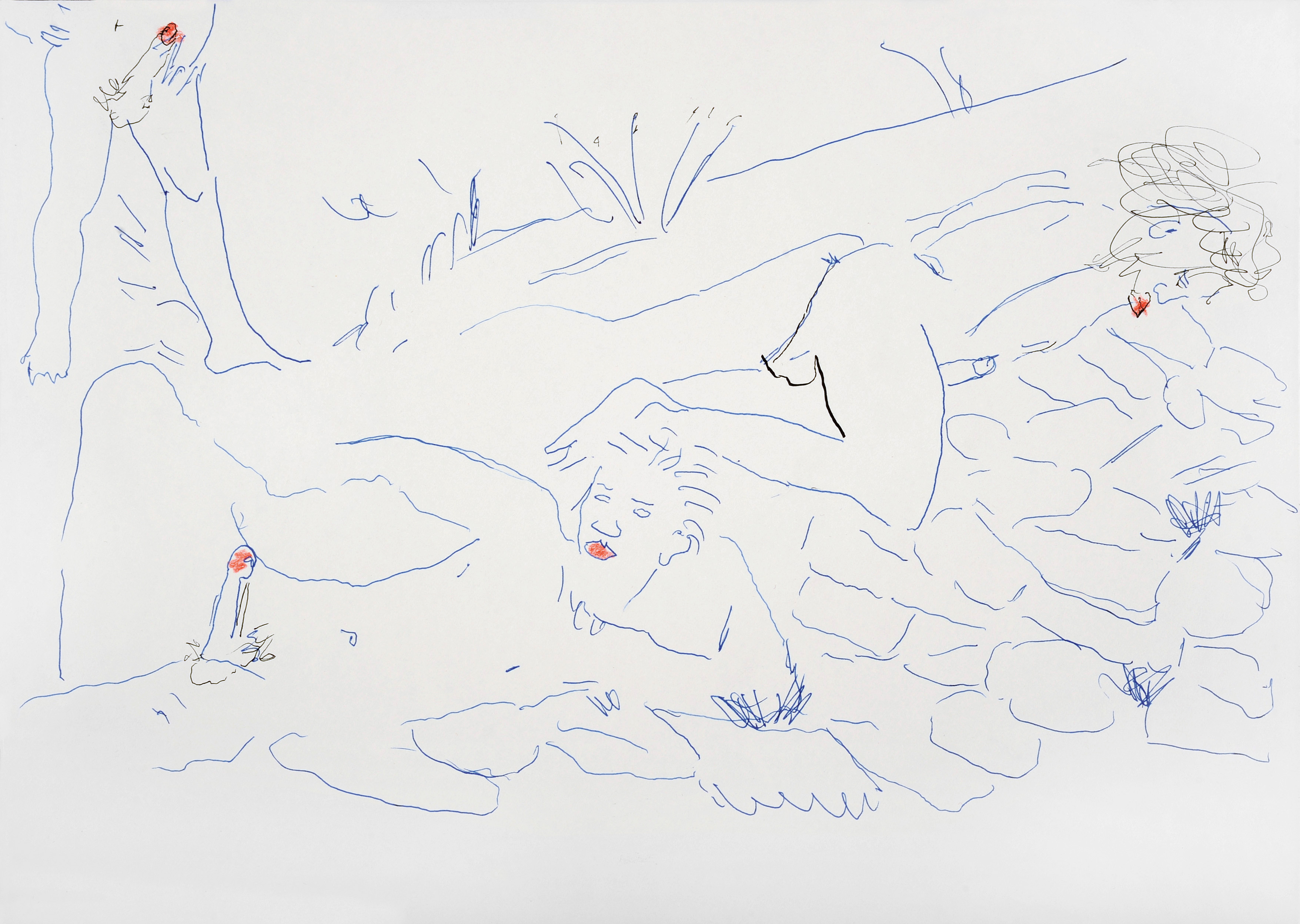
Drawing by Pierre Guyotat, 2016
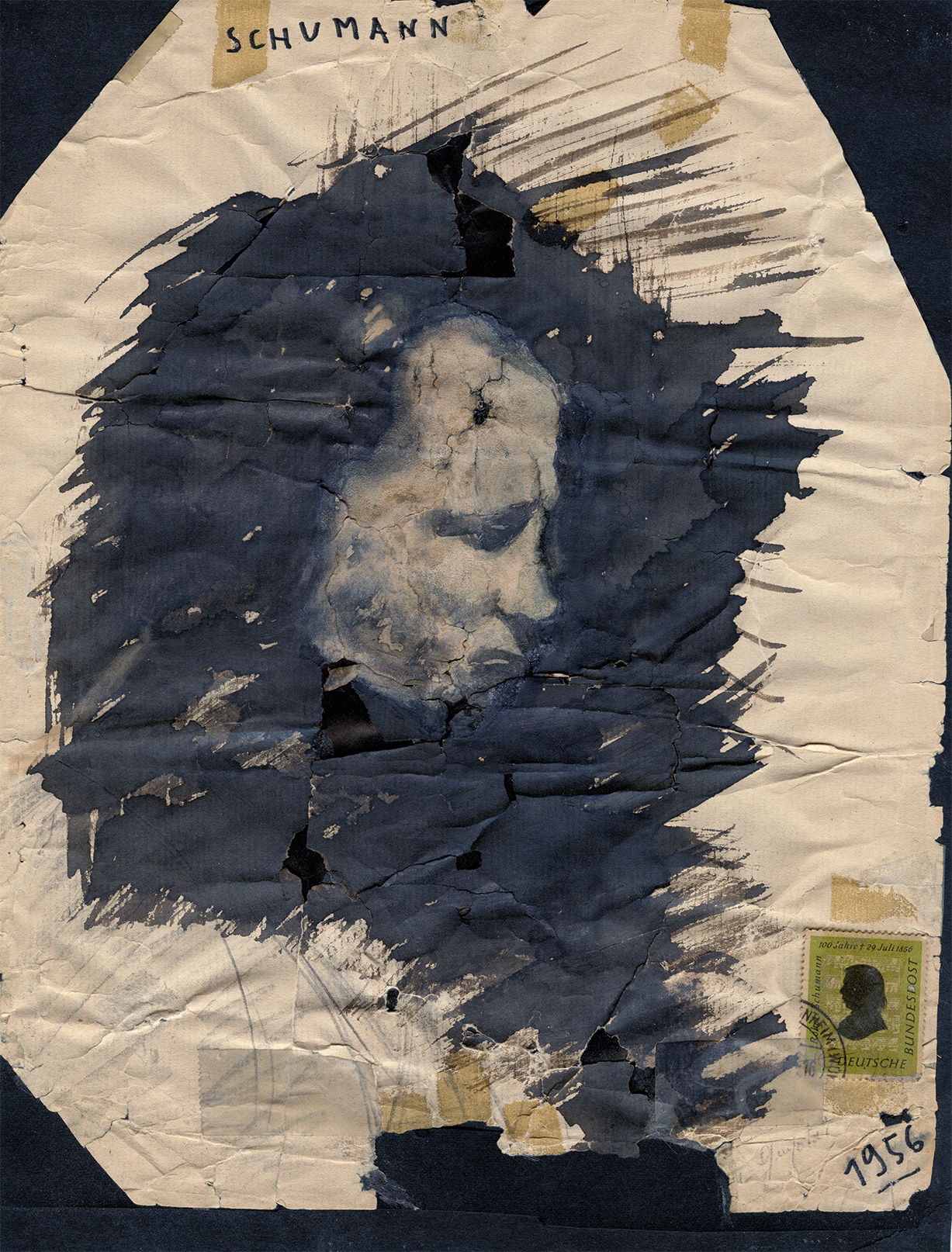
“I did this portrait of Robert Schumann at the age of sixteen, after a daguerreotype showing Clara at the piano and Robert listening—he stands with his arm bent and his hand on his chin. One of the first photographs of the couple. The occasion was the centenary of Schumann’s death, July 29, 1956. Two or three artists, aside from Gauguin, who impressed me the most had closely lying anniversaries: the hundredth anniversary of the birth of Rimbaud was 1954, two years after the centenary of the death of Schumann. I was very taken with his music, his so sublime and tragic life. A friend had sent me a postcard from Germany with a centennial stamp, which is in the pen-and-ink drawing. I have “Beethovenized” Schumann. I wanted to express that for me this music is one of will, of optimism, of resistance to madness. Early on I had the idea that artistic genius could only end in madness. As we know, in his early years Schumann fluctuated between literature and music; at the end of his life, when he again gave music a try in the Endenich sanatorium, he was putting together a collection of poetry from all eras; I think the title should be The Garden of Poets.” P.G.
D.G.: One thing that really struck me about the exhibition was the reaction of a certain number of artists, and of young generations as well, who suggest a still larger readership. There’s a sense that reading your work, the texts you’ve written, changes the lives of many young people who are thinking of becoming artists, who believe in art. How does this affect you?
P.G.: It affects me when I find out about it. I’ve seen the effects over the years. It can indeed produce an artist or a writer. It can give someone a self-revelation, or else help him finally decide not to write. There are people who’ve told me it was like a slap in the face, truly discouraging.
Naturally, it’s a pleasure to hear that it has provoked a need to produce. I think that’s the way it usually works. The other way at least has the merit of halting a process that could end up being unhealthy. But, of course, you can always ask: is it true? Was it really such-and-such work that caused the effect? After all, it might have come along after other works had loosened the cork. I don’t know. In any case, it’s preferable when it nurtures somebody’s need to live.
I do everything I can in my writing to make the thing beautiful. I feel that all those figures are ringed with nimbuses, like the figures in Fra Angelico’s paintings. All of the figures, even the dogs: everyone is ringed with that nimbus of light. I know that it’s not always read that way, but that’s a mistake. That’s how I see it. It’d be terrible if it weren’t like that.
Looking at ikons, primitive figures, nimbuses, you ask yourself a lot of questions. In the bedroom where I was born, above the bed, there was a lovely, genuine ikon from Russia. That is what I’m after. Just as I think there must be sustained melody in every work. When you listen to great works of classical music—especially Beethoven—you can perceive the extraordinary melody in them, regardless of their dour and serious reputation. The music is almost explicative. It’s no longer the polyphony of the Middle Ages or the Renaissance. It’s explicative music, where the thing is taken apart. You see that it’s always beautiful, always light, and always has melody. Beethoven is melody; it’s sound. It’s not just philosophical demonstration. It’s beautiful, and it’s pretty, and it resonates like birdsong, like the most beautiful sounds in nature. Beethoven himself said that it was music from the heart to go straight to the heart. That’s how it holds together.
There are musical and even pictorial works that are meant to be like emanations of nature but lack melody. They don’t last, and we listen to them merely out of curiosity. But works that are very serious hold up thanks to melody. All the notes are marvelous, and the thing sings. How to explain it? I’d like everything I do to sing all the time. The surface must be an absolutely singing surface, even if what lies beneath is coarse.
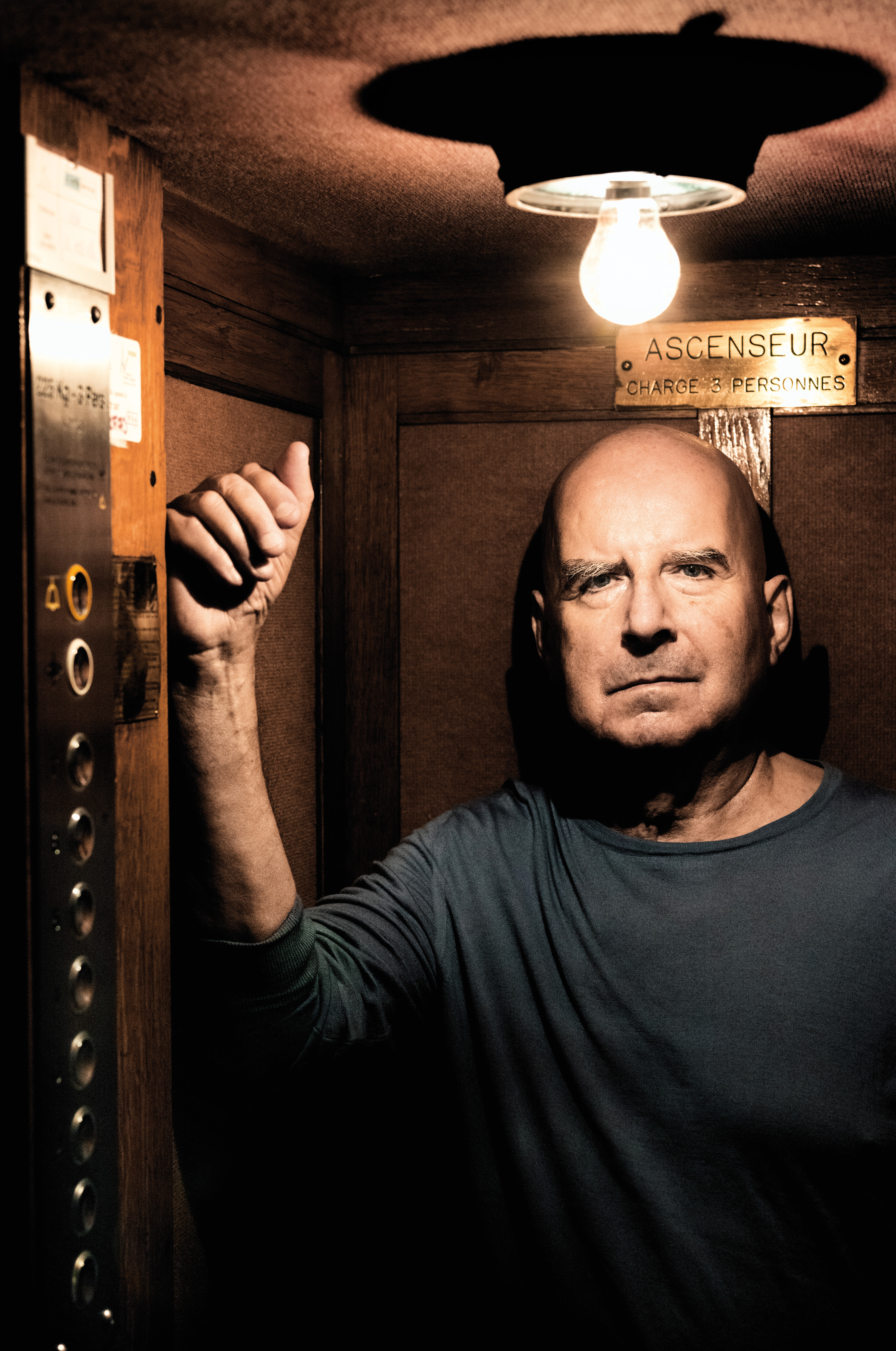
Pierre Guyotat, Paris 2017.
Photo: Mathias Bothor




